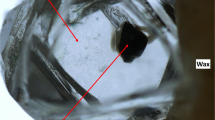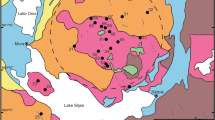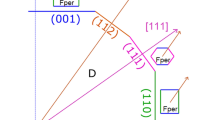Abstract
U–Pb, Rb–Sr (ref. 1) and Sm–Nd systematics2 in inclusions in diamonds suggest strongly that some diamonds are at least 2.0 Gyr old. Such antiquity is also inferred for some diamonds from their very primitive helium isotopic composition3. However, there has been almost no direct radiometric dating of diamonds, except for conventional K–Ar dating4,5, the results of which are questionable due to the possible presence of excess 40Ar. To avoid this problem, we have applied a K–Ar isochron dating method6 to ten diamonds from Zaire. The experimental data show good linear correlations in both the 40Ar–K and 40Ar/36Ar–K/36Ar diagrams. These correlations must reflect either an isochron-type relationship or the trapping of an unknown component in the diamonds. In the former case the anomalously high age (6.0 Gyr) casts doubt on the assumption of uniformity in the isotopic abundance of 40K.
This is a preview of subscription content, access via your institution
Access options
Subscribe to this journal
Receive 51 print issues and online access
$199.00 per year
only $3.90 per issue
Buy this article
- Purchase on Springer Link
- Instant access to full article PDF
Prices may be subject to local taxes which are calculated during checkout
Similar content being viewed by others
References
Kramers, J. D. Earth planet. Sci. Lett. 42, 58–70 (1979).
Richardson, S. H., Gurney, J. J., Erlank, A. J. & Harris, J. W. Nature 310, 198–202 (1984).
Ozima, M. & Zashu, S. Science 219, 1067–1068 (1983).
Ozima, M., Zashu, S. & Nitoh, O. Geochim. cosmochim. Acta 47, 2217–2224 (1983).
Ozima, M., Takaoka, N., Nitoh, O. & Zashu, S. in Materials Science of the Earth's Interior (ed. Sunagawa, I.) 375–386 (Terra Scientific, Tokyo, 1984).
Hayatsu, A. & Carmichael, C. M. Can. J. Earth Sci. 14, 337–345 (1977).
Hensley, W. K., Bassett, W. A. & Huizenga, J. R. Science 181, 1164–1165 (1973).
Imamura, M., Shima, M. & Honda, M. Z. Naturf. 35A, 267–279 (1980).
Hayashi, C., Nakazawa, K. & Nakagawa, Y. in Protostars and Planets Vol. 2 (eds Black, D. C. & Matthews, M. S.) 1100–1154 (University of Arizona Press, Tucson, 1985).
Stevenson, D. J. Science 214, 611–619 (1981).
Sasaki, S. & Nakazawa, K. J. geophys. Res. (in the press).
Becker, R. H. & Pepin, R. O. Earth planet. Sci. Lett. 70, 1–12 (1984).
Author information
Authors and Affiliations
Rights and permissions
About this article
Cite this article
Zashu, S., Ozima, M. & Nitoh, O. K–Ar isochron dating of Zaire cubic diamonds. Nature 323, 710–712 (1986). https://doi.org/10.1038/323710a0
Received:
Accepted:
Issue Date:
DOI: https://doi.org/10.1038/323710a0
This article is cited by
-
Volatile-rich mantle fluids inferred from inclusions in diamond and mantle xenoliths
Nature (1990)
-
Diamond dating anomalies
Nature (1989)
-
Origin of the anomalous 40Ar—39Ar age of Zaire cubic diamonds: excess 40Ar in pristine mantle fluids
Nature (1989)
-
40Ar/39Ar laser-probe dating of diamond inclusions from the Premier kimberlite
Nature (1989)
-
Mantle-derived fluids in diamond micro-inclusions
Nature (1988)
Comments
By submitting a comment you agree to abide by our Terms and Community Guidelines. If you find something abusive or that does not comply with our terms or guidelines please flag it as inappropriate.



